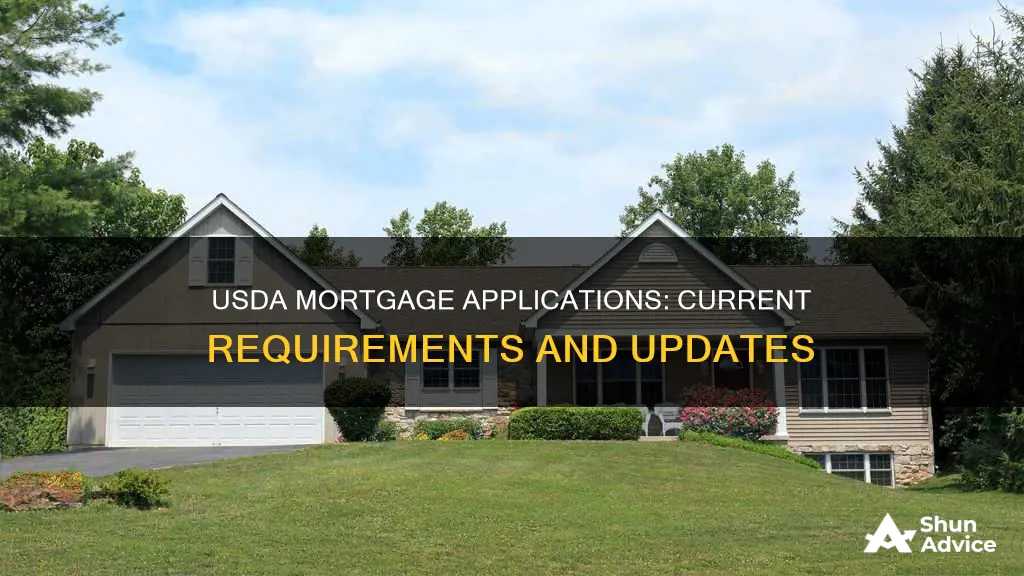
USDA loans are a great option for aspiring homeowners in rural areas, offering zero-down-payment mortgages with no annual mortgage insurance. The U.S. Department of Agriculture backs these loans, which are provided by approved private lenders, including banks, mortgage lenders, and credit unions. With lower interest rates and lenient credit score requirements, USDA loans make homeownership more accessible to low- and moderate-income families.
USDA loan applicants must meet specific eligibility requirements, including demonstrating stable income, a minimum credit score of 640, and a debt-to-income ratio of up to 41%. Additionally, the property must be located in a USDA-eligible area and meet certain safety and size standards.
The USDA offers three main loan programs: the Single-Family Housing Direct Loan Program, the Single-Family Housing Guaranteed Loan Program, and the Single Close Construction-to-Permanent Loan. Each program has unique features and requirements, catering to the diverse needs of aspiring homeowners in rural areas.
In conclusion, USDA loans present a valuable opportunity for those seeking to purchase a home in qualifying rural locations, making the dream of homeownership more attainable for many.
| Characteristics | Values |
|---|---|
| Loan type | Direct or guaranteed |
| Interest rate | Capped at 4.375% for direct loans; 6.50% for guaranteed loans; can be as low as 1% following payment assistance |
| Repayment term | Up to 33 years for direct loans; 30 years for guaranteed loans; up to 38 years for very low-income borrowers |
| Down payment | Zero down payment |
| Income requirements | Must demonstrate stable and dependable income, typically for at least 24 months before applying; must meet income eligibility requirements, which vary by location and household size |
| Credit score | Minimum of 640, though this may vary by lender |
| Debt-to-income ratio | Up to 41% of gross monthly income, with exceptions based on credit score and cash reserves |
| Citizenship status | Must be a U.S. citizen, U.S. non-citizen national, or qualified alien with a valid Social Security number |
| Property location | Must be in an eligible rural or suburban area |
| Property type | Single-family housing |
| Primary residence | Yes |

Income requirements
The USDA offers three main loan programs: Single-Family Housing Direct Home Loans, Single-Family Housing Guaranteed Loans, and Single-Close Construction-to-Permanent Loans.
The Single-Family Housing Direct Home Loan Program, also known as the Section 502 Direct Loan Program, assists low- and very-low-income applicants in obtaining decent, safe, and sanitary housing in eligible rural areas. To qualify, applicants must have an adjusted income that is at or below the applicable low-income limit for the area where they plan to buy a house. They must also demonstrate the willingness and ability to repay the debt. The amount of assistance provided is determined by the adjusted family income.
The Single-Family Housing Guaranteed Loan Program, also known as the Section 502 Guaranteed Loan Program, assists approved lenders in providing low- and moderate-income households with the opportunity to own adequate, modest, decent, safe, and sanitary dwellings in eligible rural areas. The program provides a 90% loan note guarantee to approved lenders to reduce the risk of extending 100% loans to eligible rural homebuyers.
General Income Requirements for USDA Loans
In addition to the specific income requirements for each loan program, there are also general income requirements that applicants must meet to be eligible for a USDA loan. Applicants must demonstrate stable and dependable income, typically for at least 24 months before applying. The debt-to-income ratio, including future mortgage payments, should generally not exceed 41% of gross monthly income, with exceptions based on credit score and cash reserves.
To determine eligibility, applicants can use the Single Family Housing Direct Self-Assessment tool, which considers information such as general household composition, monthly income, monthly debts, property location, estimated property taxes, and estimated hazard insurance. Applicants can also contact a USDA-approved lender to get pre-qualified or pre-approved for a mortgage. During this pre-qualification process, the lender will review the applicant's financial situation and provide an estimate of how much they can borrow with a USDA loan.
Impac Mortgage's Size and Scope: A Comprehensive Overview
You may want to see also

Property location
To be considered rural, a community must have no more than 10,000 residents. If the area has a population between 10,001 and 20,000, it cannot be located in a Metropolitan Statistical Area (MSA). For areas with 20,001 to 35,000 residents, the area must have previously been considered rural but lost this status in the 1990, 2000, or 2010 Census.
To determine if a property is located in an eligible rural area, applicants can use the USDA's online tools. The USDA Eligibility Site allows applicants to enter a specific address to determine eligibility. Additionally, the USDA Loan program links provide information on eligible areas, and the USDA property eligibility map shows eligible areas in specific regions.
It is important to note that the property must be the applicant's primary residence and not an investment or income-earning property. The USDA also requires applicants to meet income eligibility requirements, demonstrate a willingness and ability to repay the debt, and meet citizenship or eligible non-citizen requirements.
Freedom Mortgage: A Giant in the Industry
You may want to see also

Credit score
While the USDA does not have a hard and fast credit score requirement, USDA-approved lenders typically require a minimum credit score of 620 or 640 for guaranteed loans. If your credit score is below 620 or 640, depending on the lender, your loan will need to go through manual USDA underwriting, and you may need to compensate with a low debt-to-income ratio, a large savings account, or other financial factors that reduce your risk as a borrower.
If your credit score is below 640, your lender may still manually underwrite your USDA loan application. A designated loan underwriter will review your documents and application by hand instead of automating the process with the USDA Guaranteed Underwriting System (GUS). Manually underwritten applications typically require other strengthening income or asset information in your application. These factors give strength and showcase your ability to repay the loan, such as a current mortgage or rent payment that is higher than what your new mortgage payment will be. Lenders call these compensating factors or extra assurance that you can repay the loan, even with a less-than-perfect credit score.
To improve your credit score, you can pay down debts, ask for a credit line increase, and alert credit bureaus of any errors on your report. Improving your credit score can help you qualify for better USDA loan rates.
Mortgage Theft: A Common Crime You Need To Know
You may want to see also

Debt-to-income ratio
The USDA offers three main loan programs: Single Family Housing Direct Home Loans, Single-Close Construction-to-Permanent Loans, and Single Family Housing Guaranteed Loans. These loans are provided by approved private lenders and backed by the USDA. The USDA does not set specific loan limits, but the maximum mortgage loan size is limited by your household income and debt-to-income ratio (DTI).
The USDA requires a DTI of up to 41%, with some flexibility depending on the borrower's situation. This includes monthly debts like future mortgage payments, HOA dues, and flood insurance. Lenders will also consider your credit score and cash reserves when determining your eligibility for a loan.
To improve your financial standing and secure the best USDA mortgage rates, you should aim to lower your DTI by paying off high-interest debts. This demonstrates your ability to manage the loan and make timely payments. You can use a USDA mortgage calculator to get an estimate of how much you can borrow with a USDA loan.
The USDA also offers payment assistance to increase an applicant's repayment ability. This is a type of subsidy that reduces the mortgage payment for a short time and is determined by the adjusted family income.
Mortgage Business: A Giant Industry Overview
You may want to see also

Loan options
The USDA offers three main loan programs:
The Single-Family Housing Direct Home Loan Program
Also known as the Section 502 Direct Loan Program, this program assists low- and very-low-income applicants in obtaining decent, safe, and sanitary housing in eligible rural areas. The program provides payment assistance to increase applicants' repayment ability, and the amount of assistance is determined by the adjusted family income. The interest rate when modified by payment assistance can be as low as 1%, and the payback period can be up to 38 years for very low-income applicants.
The Single-Family Housing Guaranteed Loan Program
Also known as the Section 502 Guaranteed Loan Program, this program assists approved lenders in providing low- and moderate-income households with the opportunity to own adequate, modest, decent, safe, and sanitary dwellings as their primary residence in eligible rural areas. Eligible applicants can purchase, build, rehabilitate, improve, or relocate a dwelling in an eligible rural area with 100% financing. The program provides a 90% loan note guarantee to approved lenders to reduce the risk of extending 100% loans to eligible rural homebuyers.
The Single Close Construction-to-Permanent Loan Program
This program is for those seeking to build a home and offers a current interest rate of 5.125% for low-income applicants.
Other Loan Options
In addition to these three main programs, the USDA also offers loan refinancing options for existing borrowers and the opportunity to receive gifts or have the seller pay for closing costs. The USDA sets its income limits by county, and interested applicants can use the agency's income eligibility map to find their area's median household income.
What Are the Chances of Assuming a Mortgage?
You may want to see also
Frequently asked questions
The USDA guaranteed home loan program, officially known as Section 502 Guaranteed, has the following requirements:
- The property must be located in a USDA-approved area.
- The household must earn no more than 115% of the area's median income (AMI).
- The applicant must be a U.S. citizen, U.S. non-citizen national, or Qualified Alien with a valid Social Security number.
- The applicant must demonstrate stable and dependable income, typically for at least 24 months before applying.
- The applicant must have a minimum credit score of 640, though this may vary by lender.
- The applicant's debt-to-income (DTI) ratio should not exceed 41%, with some flexibility depending on their situation.
The interest rates for USDA loans vary and are dependent on multiple factors. The average interest rate for USDA guaranteed loans currently sits around 6.50%, while the current interest rate for a conventional 30-year fixed mortgage is 6.78%. The interest rate for a USDA Direct Loan is currently 4.75%. The interest rate for the Section 502 Direct Loan Program is currently capped at 4.375% but can go as low as 1% following payment assistance.
The application process for a USDA loan is similar to other home loans. First, compare rates and choose a lender. Next, complete an application and provide financial documents, including proof of income eligibility (e.g., pay stubs, tax returns). Then, await approval and set a closing day. It is recommended to get pre-qualified or pre-approved by a USDA-approved lender to get an estimate of how much you can borrow.







